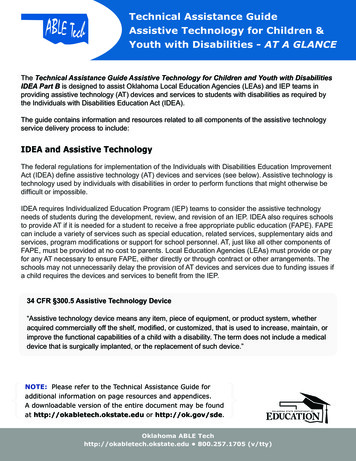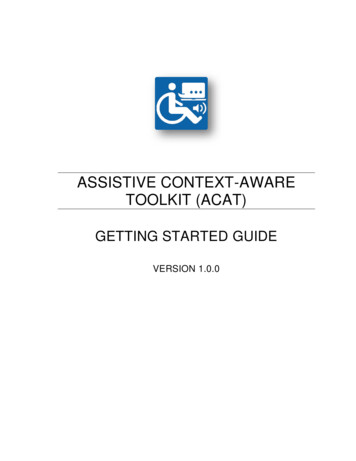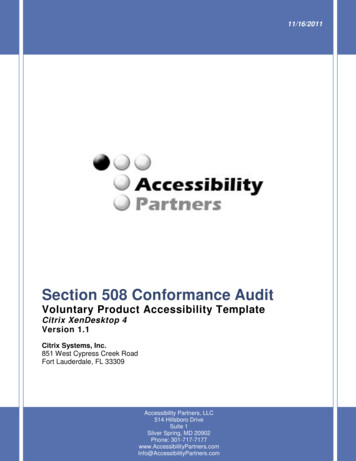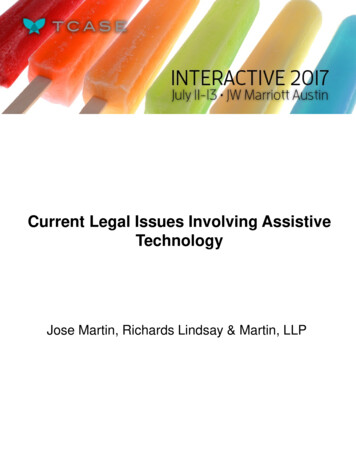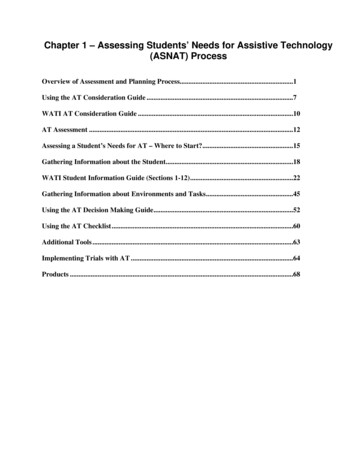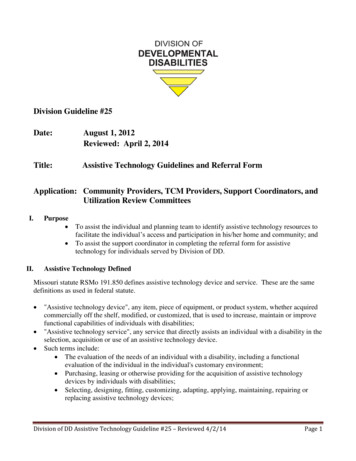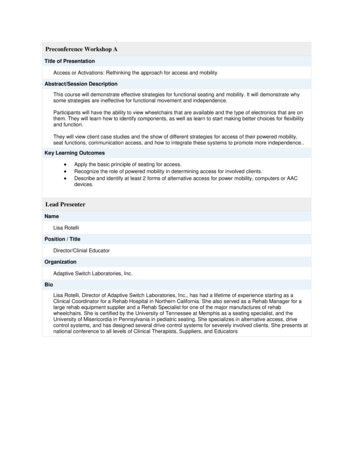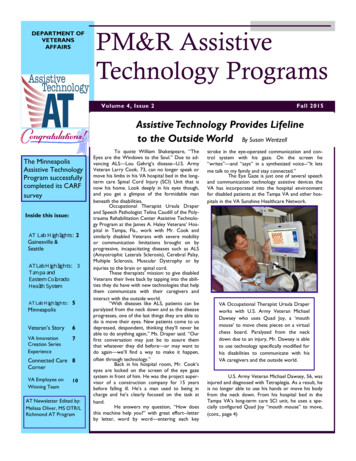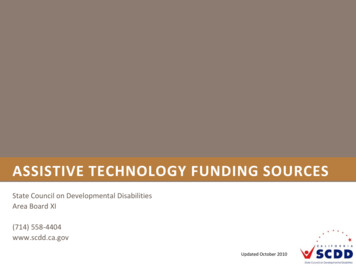
Transcription
ASSISTIVE TECHNOLOGY FUNDING SOURCESState Council on Developmental DisabilitiesArea Board XI(714) 558-4404www.scdd.ca.govUpdated October 2010
The State Council on Developmental Disabilities is established by state and federal law as anindependent state agency to ensure that people with developmental disabilities and theirfamilies receive the services and supports they need to live independently and productively, inthe least restrictive environment possible.The Council collaboratively advocates, promotes, and implements policies and practices thatachieve self-determination, independence, productivity, and inclusion in all aspects ofcommunity life for Californians with developmental disabilities and their families.What We Do? Community outreach Training Information and referral Support and educate communities Facilitate interagency collaboration Eliminate barriers to community services Encourage self-advocacy and communityparticipation Inform policymakers Demonstrate new approaches to servicesand supports Protect and advocate for consumer rightsAREA BOARD XIWho We Are?
Funding Sources of Assistive Technology School District / Special Education Regional Center Medi-Cal California Children’s Services Department of Rehabilitation Employer Social Security Administration (via PASS or IRWE)Accessing Community Resources Assistive Technology Exchange Center (ATEC) Team of Advocates for Special Kids (TASK) Tech Center Dayle McIntosh Center (Independent Living Center) California Assistive Technology Exchange (CATE) Harbor Regional Center’s Assistive Technology LabOBJECTIVESDiscussion Topics
SCHOOL DISTRICT / SPECIAL EDUCATION
Eligibility Criteria Specially designed instruction and relatedservices to meet the unique needs ofstudents with disabilities Classroom instruction Home instruction Vocational education/instruction Physical educationIdentified by the IEP team as a student with: Mental retardation Hearing impairment Speech and language impairment Vision impairment Emotional disturbance Orthopedic impairment Autism Traumatic brain injury Specific learning disability Other health impairments (OHI) No cost to families (FAPE) Provided in the least restrictiveenvironment (LRE) Implementation of services/supports toassist a student with a disability inprogressing toward IEP goals and objectives “Necessary to benefit from specialeducation” Educational criteria versus medical criteriaSCHOOL DISTRICT / SPECIAL EDUCATIONOverview
Assistive technology device means Any item, piece of equipment, or product system Customized, non-customized, or modifiedUsed to increase, maintain, or improve functional capabilities of a student with a disability.*Assistive technology in the school setting does not include any medical-type device, such asone that would be surgically implanted.(20 USC 1401(1)) (34 CFR 300.5)Assistive Technology Examples Alternative computer keyboards (IntelliKeys) Alternative mouse (pointing system) Page turner for books (GEWA/Infralink) Communication device (DynaVox) Children’s talking dictionary (Franklin Product) Switch adapted toy Pencil grip Highlighting tape Special paper options (NCR paper, raised orbold lines)SCHOOL DISTRICT / SPECIAL EDUCATIONEducational Definition
Assistive technology service means any service that directly assists a student with a disabilityin the selection, acquisition, or use of an assistive technology device.This includes Evaluation of the student’s needs Purchasing, leasing, or providing for the acquisition of the assistive technology device Selecting, designing, fitting, customizing, adapting, applying, maintaining, repairing,or replacing such device Coordinating and using other therapies, interventions, or services with AT devices Training or technical assistance for the student, family, professionals(20 USC 1401(2)) (34 CFR 300.6)SCHOOL DISTRICT / SPECIAL EDUCATIONEducational Definitions
If the student needs an assistive technology device to benefit from his/her educationalprogram, it must be written in the IEP!Benefit means making meaningful progress toward IEP goals and objectives (EC 60010) Develop goals and objectives that are assistive technology related “Using an electronic communication device, John Doe will ” Will the use of an assistive technology device enable the student to be educated in the LRE?“The IEP team shall consider whether the child needs assistive technology devices andservices” to assure that the student will benefit from special education.(20 USC 1414(d)(3)(B)(v)) (EC 56341.1)SCHOOL DISTRICT / SPECIAL EDUCATIONDetermining Need
Although the school shall consider thestudent’s assistive technology needs, you canrequest an assessment if you feel that this isbeing overlooked.Make your request in writing!Inquire on the background, training, andexperience of the person conducting theassessment. Assistive Technology Specialist Speech and Language Pathologist(SLP) for augmentative andalternative communicationassessments SLP needs experience withcommunicationdevices/technologyAssessment TimelinesWithin 15 days of the date of the request,parent should receive a proposed assessmentplanParents have 15 days from the date of receiptto consent to the proposed assessment planFollowing parent’s consent, the school has 60days to conduct the assessment(EC §56043(a)(b)(c))SCHOOL DISTRICT / SPECIAL EDUCATIONMaking the Request Known
Following completion of the assessment andthe recommendations for an assistivetechnology device is agreed upon by the IEPteam The school district buys the recommendedassistive technology device for use At school At home, if it is necessary foreducational benefit The device is the property of the school andbelongs to the school! The school must repair andmaintain the device.Relevant Questions / Tips Is there an option to buy the device afterthe student graduates school? Request to be a part of the AT training – thetraining for the student, school personnel,classroom staff, etc. What is the warranty, optional insurance onthe AT device?Safeguards Reconvene for another IEP meeting Compliance complaint Due process hearing Office of Civil Rights at the U.S. Departmentof Education (for Section 504 students)SCHOOL DISTRICT / SPECIAL EDUCATIONFunding
REGIONAL CENTER FUNDING
Eligibility Criteria for On-Going ServicesRegional centers are private, non-profitcorporations funded/contracted by theDepartment of Developmental Services (DDS)to provide and/or coordinate services andsupports to persons with developmentaldisabilities.Qualifying developmental disability Mental retardation Epilepsy Cerebral Palsy Autism “Fifth Category” - other disabling conditionsfound to be closely related to or to requiretreatment similar to that required forindividuals with mental retardation 21 regional centers within CaliforniaPrimary agencies responsible forserving persons with developmentaldisabilitiesOffers a comprehensive set ofservices and supports, includingassessments and case managementAvailable for all ages Early Start: 0-3 years Lanterman/On-Going Services:ages 3 Established by law – Lanterman Act WIC 4500 et seq. Onset prior to age 18 Condition likely to continue indefinitely Condition presents a substantial disability in 3or more life areas Learning Self-care Receptive/expressive language Mobility Self-direction Capacity for independent living Economic self-sufficiencyREGIONAL CENTEROverview
Consistent with the Lanterman Developmental Disabilities Services Act, regional centers classifyassistive technology as “adaptive equipment and supplies” under the “services and supports”provision (WIC §4512(b)).Regional Center of Orange County further defines equipment and supplies as“adaptive devices or equipment which will enable [persons with developmental disabilities] tomaintain or maximize their independence” (per RCOC POS Guidelines).Assistive Technology Examples Wheelchairs Hospital beds Communication devices And other necessary appliances and supplies(WIC §4685(c)(1))REGIONAL CENTERRegional Center Definition
Under the Lanterman Act, adaptive equipment and supplies must be directed toward : The alleviation of a developmental disability; or toward The social, personal, or economic habilitation or rehabilitation; or toward The achievement and maintenance of independent, productive, normal lives(WIC 4512(b))You need to establish: The need for an assistive technology (AT) device is related to your qualifyingdevelopmental disability The AT device is necessary to maximize your developmental potential It will help with employment, community integration, independence The need is documented in your specific Individual Program Plan (IPP) You have sought out other funding sources first , e.g. school district, insurance, etc. Regional centers are the payor of last resortREGIONAL CENTERDetermining Need
Make your request in writing!Request an IPP meeting to discuss yourrequest and why the AT device is needed. Request that an authorized decisionmaker be present for the IPP Ensure the regional centerdocuments your request in the IPPor via an IPP addendumIf you do not have a specific AT device inmind, first ask the regional center to fund foran AT evaluation/assessment with ATEC (Goodwill) TASKATEC or TASK will provide device-specificrecommendations that best suit your needs.Timelines Regional center must hold an IPP meetingwithin 30 days of your request. Otherwise, the IPP will be held annually orquarterly. The IPP should take place no less often thanonce every three years.(WIC §4646.5(6)(b)Expect a decision to be made at the IPPmeeting when an authorized decision makerpresent, ORWithin a reasonable amount of time for theservice coordinator to present the request toteam/resource group.REGIONAL CENTERMaking the Request Known
Once the need for an AT device isestablished, regional center will fund forsuch a device pending the IPP and anyassessments, if needed.When regional center funds:Relevant Questions / Tips Who will provide the training for thedevice? Parents may choose to be presentduring training. Even if regional center pays for the device,ask if you can private pay for the extendedwarranty (just in case)? The assistive technology devicebelongs to the person with thedevelopmental disability (consumer) The consumer is responsible for allmaintenance and repairs As the device belongs to theconsumer, it can be used anywhere athome, work, and in the community.Safeguards If necessary, schedule another IPP meetingto work out any differences/concerns. Request a written denial Fair hearing Informal meeting and mediation areboth voluntaryREGIONAL CENTERFunding
MEDI-CAL
Eligibility Criteria Medi-Cal is a state and federally-fundedprogram.Linked to SSI benefits, for those who areeligible by Disability status Income CalOptima is the managed health care planfor Orange County Provides health insurance for OrangeCounty children, low income families, andpersons with disabilities.(For children) Institutional Deeming viaregional center Disregards parental incomeOtherwise, you must qualify per incomeguidelines set by the State. Contact your local Social ServicesAgencyShare-of-cost or emergency Medi-Cal may beavailable as well. Emergency Medi-Cal is not likely tofund an assistive technology deviceMEDI-CALOverview
Medi-Cal classifies assistive technology as “durable medical equipment” or “medical supplies”and the patient must first obtain prior authorization via a Service Authorization Request (SAR).CalOptima and California regulations defines durable medical equipment as equipment that is(1) Used repeatedly;(2) Used for a medically-related purpose;(3) Generally only useful to the person with the disability, illness, or injury; and(4) Appropriate for use in and out of the person’s home(22 CCR 51160)Durable Medical Equipment Examples Walkers Canes Wheelchairs Respirators Helmets Body or leg braces Special beds Communication devices(22 CCR §51521)MEDI-CALMedi-Cal Definition
CalOptima will fund for a communication device or similar equipment that is consideredassistive technology if it is medically necessary.The Department of Health Care Services (DHCS) defines medical necessity or medicallynecessary services to be Those services reasonable and necessary to protect life, To prevent significant illness or significant disability, or To alleviate severe painCalOptima/Medi-Cal will fund for a communication device or similar equipment provided thefollowing criteria are met: The patient’s clinical condition meets the definition of medical necessity; The proposed treatment meets objective medical criteria; The need is properly documented on the SAR (Service Authorization Request); and The service request is reasonable in cost and consistent with the patient’s medicalneeds(Per Manual of Criteria for Medi-Cal Authorization, last revised August 5, 2004, page 1)MEDI-CALDetermining Need
It all starts with the Primary Care Physician!Ask your Primary Care Physician to getapproval (prior authorization) from yourhealth care network (e.g. CHOC, UCI) for anassistive technology assessment. Must be done by a qualified personor rehabilitation centerIf the assessment supports your need for theequipment, Primary Care Physician must requestthe equipment from your healthcare network.The request should include a copy of theassessment.Timelines The health care network must approve ordeny a request for durable medicalequipment, including communication devicesor similar equipment, within 5 working daysof receipt of the request. The request may be deferred for 30 days toallow for completion of an assessment andsubmission of medical necessity documents. Once approved, it should not take longerthan 3 months for the provider to deliver theequipment, if the item is common and does notrequire customizationMEDI-CALMaking the Request Known
Once the Primary Care Physician and theassessment establishes the medical need forthe AT device, CalOptima will then fund forthe requested equipment.When CalOptima funds:Relevant Questions / Tips You will need to find and pay for trainingon how to use the AT device. Even if CalOptima pays for the device, ask ifyou can pay for the extended warranty. Ask about the timelines for replacement ofoutdated equipment. The assistive technology devicebelongs to the person (Medi-Calbeneficiary). The Medi-Cal beneficiary isresponsible for all maintenance andrepairs As the device belongs to thatindividual, it can be used anywhere athome, work, and in the community.Safeguards If your physician’s request is denied, youmust be notified in writing within 3 workingdays of the date of denial. You may file a fair hearing to appeal thedecision.MEDI-CALFunding
CALIFORNIA CHILDREN’S SERVICES (CCS)
Eligibility Criteria Statewide program of specialized medicalcare providing Medical case management Physical and occupational therapy Financial assistance for children withcertain health care needsCCS is available for those who meet thefollowing criteria: Are less than 21 years old; Are permanent California residents; Have an eligible medical condition(physically disabling or requiringmedical, surgical, or rehabilitativeservices) and Are California residents with Family adjusted gross incomeof less than 40,000 per year or Family adjusted gross incomeof more than 40,000 per yearwith out-of-pocket eligiblemedical expenses for the CCSeligible condition expected toexceed 20% of family income. Funded by State and county Services must be medically necessary andrelated to the CCS-eligible conditionMedi-Cal and CCS work jointly for childrenwho have dual eligibility CCS authorizes the services, andMedi-Cal pays for it CCS provides the Medi-Cal casemanagement CCS pays for services Medi-Cal doesnot fundCALIFORNIA CHILDREN’S SERVICESOverview
CCS, like Medi-Cal, classifies assistive technology as equipment or a service for which the childmust first obtain prior authorization for via a Service Authorization Request (SAR).CCS uses the following definitions for durable medical equipment (DME):DME-Rehabilitation: “Those assistive devices/equipment that are designed to assist a childwith mobility or self-care activities, including communication.”Criteria: “Those specific medical or physical conditions that are required to justify authorizationof the requested DME-R.”Related Factors: “Issues and considerations that assist in determining the appropriateness ofthe DME-R item being recommended.”(CCS Numbered Letter 09-0703)Durable Medical Equipment Examples Bath aids Communication systems Self-care accessories Feeding aids Toileting aids Transfer aids Gait trainers Walkers Crutches Wheelchairs Standers Head protection Sitters(CCS Numbered Letter 09-0703)CALIFORNIA CHILDREN’S SERVICESCalifornia Children’s Services Definition
CCS will fund for a communication device or similar assistive device/equipment if it is medicallynecessary.CCS defines medical necessity or medically necessary services to be Those services reasonable and necessary to protect life, To prevent significant illness or significant disability Or to alleviate severe pain(Statutes of 1985, Chapter 1411) (Manual of Criteria for Medi-Cal Authorization, last revisedAugust 5, 2004, page 1 )Medical necessity for DME-R is further defined by CCS as part of their DME Guidelines “That limitation of a mobility or self-care skill related to a CCS eligible medicalcondition which is verified by physical findings and which justifies the DME-R beingauthorized.”(CCS Numbered Letter 09-0703)According to 22 CCR §41518, “medically necessary benefits are those services, equipment,tests, and drugs which are required to meet the medical needs of the CCS-eligible medicalcondition as prescribed, ordered, or requested by a CCS physician and which are approvedwithin the scope of benefits provided by the CCS program.”CALIFORNIA CHILDREN’S SERVICESDetermining Need
How does CCS determine whether a portable communication system is medically necessary?The CCS-eligible child must meet the following criteria for a CCS physician to authorize such requestand submit a service authorization request (SAR):Medical necessity: The child requires the communication system to communicate self-care needs to others athome, school, and in the community The child is non-verbalCriteria: The child demonstrates effective functional use with family and in school/communitysettings A physician has confirmed medical necessity and Available for daily use to facilitate personal needs at home, school, and in the communityRelated factors: System allows for modifications and upgrades to accommodate increased communicationand ability School or other appropriate agency has agreed to provide ongoing training Adequate rental or trial period required prior to purchasing the device Family has demonstrated compliance by utilizing the system at home daily and The device can meet the child’s needs for at least 3 yearsCALIFORNIA CHILDREN’S SERVICESDetermining Need
It all starts with the Primary Care Physician!Ask your CCS-paneled Primary Care Physician(PCP) to submit a Service AuthorizationRequest (SAR) to CCS for approval (priorauthorization) to fund an assistive technologyassessment.If the AT assessment supports the child’sneed for the equipment, the Primary Care Physician must requestthe equipment from CCS via aService Authorization Request(SAR).The request should include a copy of theassessment.TimelinesCCS should provide benefits within areasonable amount of time; however, this isnot specifically defined in the law.After waiting a reasonable amount of time,go up the chain of command to inquire onthe status of your request.If more than two months pass without aresponse, consider filing an appeal. After acouple months, it may be better to simply filea written request for an appeal.CALIFORNIA CHILDREN’S SERVICESMaking the Request Known
Once the Primary Care Physician and theassessment establishes the medical need forthe AT device, and the SAR is approved, CCSwill then fund for the requested equipment.When CCS funds:Relevant Questions / Tips CCS provides repairs, maintenance, orupkeep of appliances and equipment Get this in writing! CCS does not provide ongoing training forusing a communication device Ask the school or regional center The assistive technology devicebelongs to the person (CCS recipient) The equipment must meet the child’sneeds for at least 3 yearsSafeguards You may file a fair hearing to appeal thedecision You must file for the appeal within30 calendar days of the notice ofaction (NOA)CALIFORNIA CHILDREN’S SERVICESFunding
DEPARTMENT OF REHABILITATION
Eligibility Criteria State agency responsible for providingvocational rehabilitation services, whichinclude Career education and training Job search and interview skills Career assessment and counseling Transportation Independent living skills Assistive technology, such asadaptive computers, listeningdevices, etc.Eligibility for services from the Department ofRehabilitation (DOR) is based on Physical or mental impairment thatmakes it “significantly difficult“ toobtain and retain employment Vocational rehabilitation services(e.g., job coaching) are needed toobtain or retain employment The person’s desire to work(29 U.S.C. §705, 29 U.S.C. §722) Individually tailored services to help peoplemeet their employment goals. Individual Plan for Employment “DOR’s mission is to work in partnershipwith consumers and other stakeholders toprovide services and advocacy resulting inemployment, independent living andequality for individuals with disabilities.”Once the above documentation/informationis submitted, then the Department ofRehabilitation Counselor will set up anappointment to Fully evaluate eligibility criteria Determine significance of disability Assess vocational rehabilitationneedsDEPARTMENT OF REHABILITATIONOverview
The Department of Rehabilitation funds for assistive technology under the headingrehabilitative technology, which is defined as: “The use of technology, engineering, or scientific principals to meet the needs of andaddress the barriers faced by people with disabilities in areas which include education,rehabilitation, employment, transportation, independent living, and recreation.Rehabilitation technology is divided into three categories:” Rehabilitative engineering Qualified person performing an evaluation and designing, fabricating, ormodifying assistive devices Assistive technology devices Item, piece of equipment, or product system used to increase, maintain orimprove your functional capabilities Assistive technology services Any service that directly helps you select, acquire, or use an assistivetechnology device(29 U.S.C. §705(30))DEPARTMENT OF REHABILITATIONDepartment of Rehabilitation - Definitions
Once the Department of Rehabilitation determines eligibility, the DOR Counselor will conduct acomprehensive vocational rehabilitation needs assessment, which can include: Assessment of your interests, skills, intelligence, and related functional capacities; Assessment of your educational achievements, work experience, vocational aptitudes; Assessment of the medical, psychiatric, psychological, vocational, educational, andenvironmental factors that affect your employment; Evaluation of your work behavior and the services you need to acquire occupational skills; Evaluation of social and behavioral patterns necessary for successful job performance; Evaluation of your work in real job situations to assess and develop your work skills; Referral for rehabilitation technology services necessary to assess and develop your abilityto perform in a work environment; Exploration of your abilities, capabilities, and capacity to perform in work situations,including experiences in which you have appropriate supports and training.The information from the assessment is then put into an Individualized Plan for Employment (IPE),which includes: Description of your employment outcome / goals Timelines for achieving goals Description of the vocational rehabilitation services you require, including AT Description of the vocational rehabilitation services provider and how the provider willdeliver services Description of how DOR will evaluate your progress toward your employment goalsDEPARTMENT OF REHABILITATIONDetermining Need
Timelines DOR has 60 days to determine eligibilityMake your request in writing!Request that the DOR Counselor refer you toa rehabilitation technology services providerto assess your need to be able to perform ina work environment. DOR should provide vocationally relatedservices and supports, such as assistivetechnology, within a reasonable amount oftime; however this is not specifically definedin the law. DOR can terminate services once yousuccessfully achieve your IPE goal or if youare deemed incapable of meeting avocational goal.DEPARTMENT OF REHABILITATIONMaking the Request Known
Once the vocational rehabilitation servicesprovider qualified to perform an ATassessment establishes the vocational needfor the AT device, DOR will then fund for therequested device.Safeguards You may request either Internal administrative review Reviewed within 15 days ofyour request or Fair hearing Takes place within 45 days ofyour requestDEPARTMENT OF REHABILITATIONFunding
EMPLOYER
Work Opportunity Tax Credit ss/Incentives/opptax/ Applicable to small businesses With revenues of less than 1,000,000 or Less than 30 full-time workers All employers can receive a tax credit up to 2,400 for each new adult hire so long as theperson Receives SSI benefits, or is a Vocational Rehabilitation referral Maximum tax credit of 5,000 per year Allows small businesses to cover ADArelated “eligible access expenditures,”including: Provision of readers for customers oremployees with vision impairments Provision of sign languageinterpreters Purchase of adaptive equipment Production of accessible formats Braille, large print, audio tape Removal of architectural barriers Fees for consulting servicesEMPLOYERADA Small Business Tax Credit
SOCIAL SECURITY ADMINISTRATION
SSDI / SSDAC Benefits (Title II Benefits)Needs-based benefit for children or adultswith a qualifying disability Benefits for children are dependenton parental income Adult benefits are based on theirincomeSSDI is an earned benefit based on theindividual’s own work record. Available benefit after one has earnedenough work creditsMust be under: Substantial gainful activity Resource limitSSDAC is an eligible benefit for “Disabled AdultChildren” whose parent is retired or deceasedand earned enough work credits through SSA. Based on a parent’s work recordSOCIAL SECURITY ADMINISTRATIONSSI Benefits
Plan to Achieve Self-Sufficiency (PASS)An Impairment Related Work Expense(IRWE) is an expense for an item or service That is directly related to youworking and That is related to a physical ormental impairmentPASS plan allows an individual to set asideincome and resources for a vocational oreducational objective.An IRWE allows an individual to deduct thecost of certain items /services needed foremployment from work earnings. Durable medical equipment Prostheses Work-Related Equipment Keyboards Page-turning devices Vision/sensory aids Etc.Costs are deducted from your earnings afteryou pay for them.SSA does not count the income and resourcesset aside in a PASS plan.PASS plan must be pre-approved by SSAThe PASS plan allows you to deduct AT costsfrom your income, including: Equipment and supplies needed forwork Building and/or vehicle modifications Purchase and maintenance of aprivate vehicleSOCIAL SECURITY ADMINISTRATIONImpairment Related Work Expense (IRWE)
ACCESSING COMMUNITY RESOURCES
Assistive Technology Exchange Center (ATEC)www.atec-oc.org1601 E. St. Andrew PlaceSanta Ana, CA 92705Phone: (714) 361.6200TTY/TTD: (714) 543.1873ATEC@ocgoodwill.orgTeam of Advocates for Special Kids (TASK) Tech Centerwww.taskca.org100 West Cerritos AvenueAnaheim, CA 92805Toll-free: (866) 828-8275 (in California)Phone: (714) 533-8275taskca@yahoo.comCenter for Applied Rehabilitation Technology (CART)Rancho Los Amigos National Rehabilitation Center7601 East Imperial HighwayDowney, California 90242Phone: (562) 401-6800Email: CARTinfo@gmail.comASSISTIVE TECHNOLOGY RESOURCESAssistive Technology Resources
Dayle McIntosh Center (Independent Living Center)www.daylemc.org13272 Garden GroveGarden Grove, CA 92843Phone: (714) 621-3300TDD: (714) 663-2087AT Exchange (formerly California Assistive Technology Exchange)https://exchange.atnet.org(800) 390-2699(800) 900-0706 (TTY)info@atnet.orgHarbor Regional Center’s Assistive Technology Labwww.harborrc.org21231 Hawthorne BoulevardTorrance, CA 90503Phone: (310) 792-4763ATLab@harborrc.orgASSISTIVE TECHNOLOGY RESOURCESAssistive Technology Resources
THANK YOU!State Council on Developmental Disabilities, Area Board XI2000 East Fourth Street, Suite 115Santa Ana, California 92705Phone: (714) 558-4404Facsimile: (714) 558-4704Website: www.scdd.ca.gov
health care network (e.g. CHOC, UCI) for an assistive technology assessment. Must be done by a qualified person or rehabilitation center If the assessment supports your need for the equipment, Primary Care Physician must request the equipment from your health care network.
